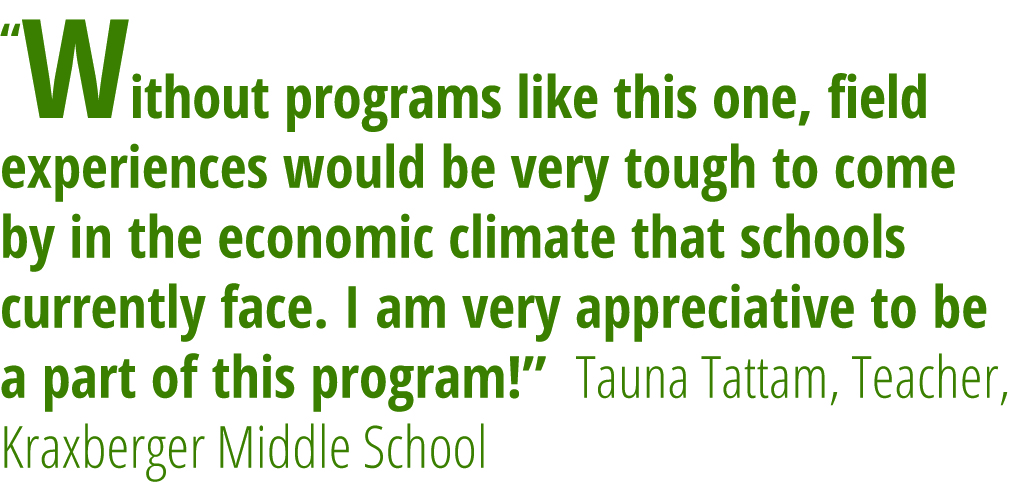The 2012-13 school year was a great success thanks to many partners, supporters and volunteers. Estuary Partnership educators engaged over 3,600 students in classroom lessons, service learning projects and on-river field trips. Building on concepts learned in the classroom, students explored local natural areas and engaged in hands-on activities that improved their local environment. Estuary Partnership educators worked with students from across our service area, from Corbett, Oregon in the Columbia River Gorge, to Ilwaco, Washington near the Pacific Ocean, leading a regional effort to connect youth to the lower Columbia River in meaningful ways.
2012 -13 Program Highlights
Rainwater from the roof of Southeast Portland school will soak into a new swale instead of draining to the city sewer, helping to support cleaner rivers. This year the Estuary Partnership completed its most recent schoolyard stormwater project at Hosford Middle School, where in addition to swale construction, the project included education in the classroom and in the field, where 75 students from three classrooms worked to plant hardy native plants adapted to periodic flooding and drought. The Estuary Partnership will continue to work with students over the next several years to maintain the swale. Hosford teachers will also use the swale for science instruction and experiments. Project partners include Hosford Middle School and Portland Public Schools. Supporters of the project include City of Portland Bureau of Environmental Services, East Multnomah Soil and Water Conservation District and New Seasons Market.
Fifth graders in Camas and Washougal have new science lessons and a huge outdoor classroom. As part of the Steigerwald Lake National Wildlife Refuge Environmental Ed ucation Committee, the Estuary Partnership worked with refuge staff, Columbia Gorge Refuge Stewards, Educational Service District 112 (ESD 112) and retired teachers to developed new science curriculum to connect 5th grade students from Camas and Washougal to the Steigerwald Lake National Wildlife Refuge (Refuge). Lack of student understanding in key science concepts prompted the ESD 112 to look for alternative ways to increase knowledge utilizing local natural spaces. The new interactive curriculum helps students understand complex concepts, such as food webs and energy flow, and helps teachers meet state science standards. The Refuge serves as an outdoor classroom where students explore and learn through hands-on activities. Three teacher workshops were held to train teachers in the new curriculum and they were well received by teachers and generated a lot of enthusiasm. To help support teachers and the implementation of the new curriculum, the Estuary Partnership field tested the activities with 5th graders during service learning field trips at the Refuge.
ucation Committee, the Estuary Partnership worked with refuge staff, Columbia Gorge Refuge Stewards, Educational Service District 112 (ESD 112) and retired teachers to developed new science curriculum to connect 5th grade students from Camas and Washougal to the Steigerwald Lake National Wildlife Refuge (Refuge). Lack of student understanding in key science concepts prompted the ESD 112 to look for alternative ways to increase knowledge utilizing local natural spaces. The new interactive curriculum helps students understand complex concepts, such as food webs and energy flow, and helps teachers meet state science standards. The Refuge serves as an outdoor classroom where students explore and learn through hands-on activities. Three teacher workshops were held to train teachers in the new curriculum and they were well received by teachers and generated a lot of enthusiasm. To help support teachers and the implementation of the new curriculum, the Estuary Partnership field tested the activities with 5th graders during service learning field trips at the Refuge.
The Watershed Postcard Exchange Project provides a unique opportunity for students to share with others about their outdoor experiences and service projects. This spring we developed and implemented the Watershed Postcard Exchange Project with Oregon and Washington schools as the culminating component of our Lower Columbia River Watershed Enhancement and Education Program (Watershed Education Program)funded in part by NOAA’s Bay Watershed Education and Training. Students participating in the Watershed Education Program created postcards using original artwork, photos and their own words to share information about their watershed service projects and on-river experiences. The postcards were distributed among participating schools and provided a unique opportunity for students to share their excitement and demonstrate that several student-driven watershed enhancement projects are happening on the lower Columbia River. Students also received a custom kid-friendly poster/map of the lower Columbia River to display their postcards and learn about other lower Columbia River watersheds.